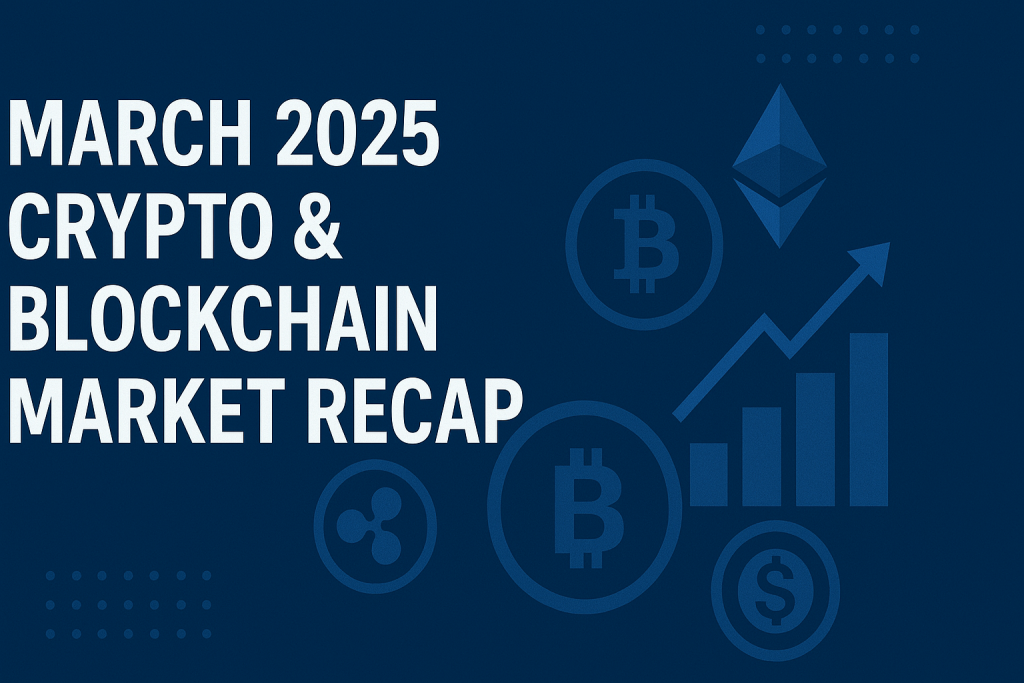March 2025 Crypto & Blockchain Market Recap

March 2025 was a pivotal month for the crypto and blockchain space, marked by significant policy shifts, major technological advancements, and increasing institutional adoption. Here are the key developments:
Key Takeaways:
- Washington pivots to crypto-friendly policies: The new U.S. administration announced plans for a strategic national crypto reserve, while regulators halted high-profile enforcement actions – a historic about-face cheered by the industry.
- Bitcoin payments go mainstream: Coinbase integrated the Lightning Network this month, enabling instant, near-zero fee BTC transactions for its vast user base and accelerating crypto’s push into everyday payments.
- Ethereum upgrade on the horizon: Ethereum’s major “Pectra” network upgrade passed testing in March, promising lower fees and even letting users pay gas with stablecoins – a leap forward in user experience that narrows the gap with faster rival chains.
- Wall Street and institutions dive in: Traditional finance deepened its crypto foray as Fidelity unveiled plans for a U.S. dollar–pegged stablecoin and a tokenized money market fund. Meanwhile, Hong Kong granted its 10th exchange license and advanced stablecoin rules to cement its status as a crypto hub.
- Regulatory clarity boosts confidence: Global regulators moved toward clearer frameworks – the U.S. FDIC green-lit banks to engage in crypto without prior approval, and Europe’s comprehensive MiCA regime kicked off its implementation phase – reducing uncertainty for banks, startups, and investors.
March 2 – U.S. President Unveils Strategic Crypto Reserve Plan
The month kicked off with a bombshell policy announcement in Washington. On March 2, U.S. President Donald Trump revealed plans to create a “U.S. strategic cryptocurrency reserve”, suggesting assets like Bitcoin, Ethereum, XRP, Solana (SOL), and Cardano (ADA) could be included. This marked an unprecedented embrace of digital assets at the federal level.
The news came on the heels of a crypto market pullback – Bitcoin had been in a month-long slide – and immediately shifted sentiment. Crypto insiders had mixed reactions: some Bitcoin proponents argued only BTC deserves a reserve spot, while others were stunned to see altcoins like SOL and ADA on the list.
President Trump’s crypto pivot fulfilled campaign promises to make the U.S. the “crypto capital” of the world. He even scheduled a White House Crypto Summit for March 7 to elaborate on the strategy and signal support for the industry.
For crypto markets, the symbolism was huge. The prospect of the U.S. government potentially stockpiling crypto injected fresh optimism. By mid-March, Bitcoin’s price began rebounding, nearing the $88K level after dipping into the mid-$70Ks during February’s regulatory uncertainty. Traders noted that policy moves from Washington had effectively become the new market driver. The White House’s crypto-friendly stance set an upbeat tone for March.
March 4 – Regulators Soften Stance, Enforcement Pullback
In the first week of March, the U.S. regulatory climate flipped from crackdown to collaboration. Following the President’s lead, agencies and lawmakers signaled a softer stance on crypto. Notably, the Securities and Exchange Commission (SEC) dismissed or paused at least eight enforcement cases against crypto firms, including high-profile lawsuits against Coinbase and Binance.
On March 3, exchange Kraken announced the SEC dropped its case against them with prejudice, meaning it cannot be re-filed. The very next day, March 4, the U.S. Senate voted to overturn a controversial IRS reporting requirement for crypto transactions. This legislative victory relieved a major compliance headache for platforms.
Market reaction to this regulatory about-face was decidedly positive. The cloud of legal uncertainty began to lift, encouraging institutional investors. Crypto prices found firmer footing as investors priced in lower regulatory risk. Industry observers noted key figures installed by the Trump administration were reorienting agencies toward innovation. Even within the SEC, a reorganization saw the crypto enforcement unit downsized and folded into a broader tech division. The implication: U.S. regulators are moving towards a more constructive approach, giving crypto businesses room to breathe.
March 5 – Ethereum’s “Pectra” Upgrade Passes Testnet
Mid-week, attention turned to tech as Ethereum’s much-anticipated “Pectra” upgrade achieved a successful testnet deployment on March 5. Pectra – a combined Prague + Electra hard fork – is Ethereum’s most significant update since the 2022 Merge.
Key features poised to be game-changers include:
- Account Abstraction: Allowing users to pay transaction fees in tokens other than ETH (like stablecoins). This could dramatically improve Ethereum’s user experience.
- Throughput Boosts: Technical tweaks to increase data capacity for Layer-2 rollups.
- Higher Staking Limits: Raising validator staking limits to 2048 ETH, enhancing efficiency.
Developers hailed the upgrade as Ethereum’s answer to newer competitors. By addressing usability and fees, Ethereum is closing the gap with high-speed networks like Solana. The successful testnet run cleared the way for a mainnet launch, tentatively expected in April pending further testing.
While ETH’s price remained steady around $2,000 in late March, sentiment was optimistic. The upgrade kept institutional interest strong, with firms like State Street reportedly working on tokenizing assets on Ethereum. Pectra’s progress suggests Ethereum is gearing up for growth by addressing key pain points.
March 12 – Coinbase Launches Lightning Payments for Bitcoin
A major fintech milestone arrived on March 12, as Coinbase integrated Bitcoin’s Lightning Network. Coinbase’s millions of users can now withdraw and send BTC using Lightning, meaning transactions settle in seconds at virtually no cost.
This integration is a watershed moment for Bitcoin as a payment system. Lightning enables fast, off-chain transactions, and Coinbase’s support is its biggest mainstream endorsement yet. In partnership with infrastructure startup Lightspark, Coinbase unlocked instant, penny-cheap bitcoin payments for everyday use. This contrasts sharply with slower, sometimes costly, on-chain transfers.
Industry reaction was enthusiastic. Coinbase’s adoption is expected to onboard tens of millions of new Lightning users, vastly expanding reach. Analysts likened it to a tipping point for Bitcoin’s utility beyond just being “digital gold.”
The implications for crypto payments are significant. Bitcoin could function more fluidly in commerce, competing with traditional payment networks on speed and cost. Coinbase’s move signals that crypto payments infrastructure is maturing.
March 19 – Hong Kong Expands Crypto Licensing to Attract Capital
Internationally, Hong Kong doubled down on its ambition to be Asia’s crypto finance hub. By mid-March, the Securities and Futures Commission (SFC) had expanded its licensing regime, issuing its 10th virtual asset exchange license and rolling out new rules for OTC trading and custody.
One notable approval on March 19 was for HashKey Capital, which obtained a license to offer crypto brokerage and investment products. This added to the flurry of licenses since retail crypto trading was legalized last year. Policymakers also introduced legislation to regulate stablecoins, aiming for clear rules to foster innovation.
Global investors noticed Hong Kong’s rapid regulatory evolution, positioning it as China’s proxy for crypto experimentation. At the Consensus Hong Kong 2025 conference, officials touted a bullish outlook, affirming their commitment to a thriving digital asset ecosystem. Binance’s APAC chief noted the positive sentiment shift complemented efforts in the U.S.
Speakers revealed that institutions once debating whether to invest in crypto are now deliberating how much to invest. With friendlier policies globally, major capital is entering the market. Hong Kong’s regulated environment could attract significant global firms.
March 26 – Fidelity Reveals Stablecoin and Tokenization Plans
Another headline came from Wall Street on March 26: Fidelity Investments signaled a deeper dive into crypto with plans to launch its own stablecoin and a tokenized fund platform.
Fidelity confirmed advanced testing of a U.S. dollar stablecoin fully backed by U.S. Treasury assets. In parallel, the firm filed an application for a blockchain-based money market fund by May 2025, effectively tokenizing a traditional fund.
This twin initiative positions Fidelity as a pioneer among traditional financial institutions embracing crypto-native infrastructure. It challenges existing stablecoin players and competes with other asset managers eyeing tokenized funds.
The significance? Growing institutional confidence amid favorable regulatory shifts. “Conditions are finally right for big finance to get in the game,” one analyst noted. Fidelity’s move could bring a trust-mark to crypto payments and signals that traditional securities are migrating onto blockchain rails, potentially allowing 24/7 trading and instant settlement. Fidelity’s announcement underscored accelerating institutional adoption.
March 28 – FDIC Eases Bank Crypto Rules, Global Frameworks Emerge
Rounding out the month, regulators delivered good news for banking and crypto integration. On March 28, the U.S. FDIC released new guidance clarifying that banks can engage in crypto activities without prior FDIC approval, provided they manage risks responsibly. This reversed a 2022 policy requiring banks to notify regulators first.
In effect, the FDIC removed a major hurdle, potentially opening the door for more U.S. banks to offer crypto custody, trading, or stablecoin services. Banking analysts noted this could revive partnerships between crypto firms and banks, improving fiat on/off ramps and trust.
The FDIC’s move capped a month of global regulatory progress.
- In Europe, the landmark Markets in Crypto-Assets (MiCA) regulation entered its implementation phase, moving towards a single EU crypto rulebook.
- In Asia, jurisdictions like Singapore and Japan continued refining their regimes, underscoring a worldwide trend toward regulatory clarity.
The industry response has been largely positive. Clear rules are preferable to uncertainty. By the end of March 2025, there was a palpable sense that the crypto sector is maturing. Governments are bringing crypto into the regulatory fold, laying the foundation for more institutional capital, broader adoption, and integration with traditional systems. March 2025 marked a significant shift in favor of the industry.
Sources:
This analysis draws upon reporting from March 2025 by industry news outlets, official statements, and market data. Key sources include:
- PYMNTS: This Week in Crypto: A Flock of Black Swan Events
- Bitcoin Magazine: Coinbase Integrates Bitcoin Lightning Network For US Exchange Users
- Bitpanda Academy: Ethereum forecast 2025: trends, scenarios and expert opinions
- CoinMarketCap Academy: Can Pectra Upgrade Put Ethereum Back in the Race Against Solana?
- AInvest: Fidelity Plans Stablecoin Launch Amid US Crypto Regulatory Reforms
- Reuters: Hong Kong expands virtual asset push with new licensing, trading options
- FDIC.gov: FDIC Clarifies Process for Banks to Engage in Crypto-Related Activities
- Hogan Lovells: The EUs Markets in Crypto-Assets MiCA Regulation — a status update
- Coinfomania: Crypto Market Today (March 26, 2025)
- TNGlobal: HashKey secures license to expand crypto service offerings in Hong Kong

